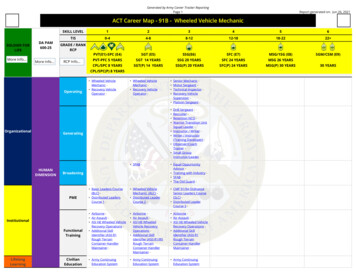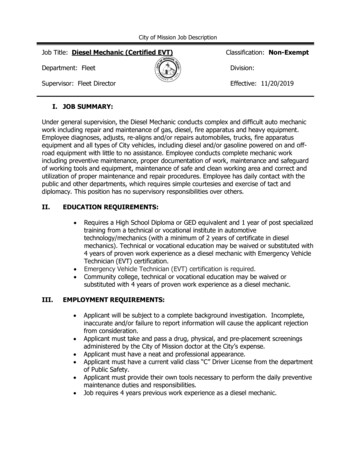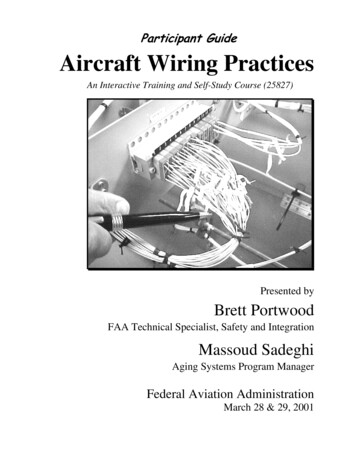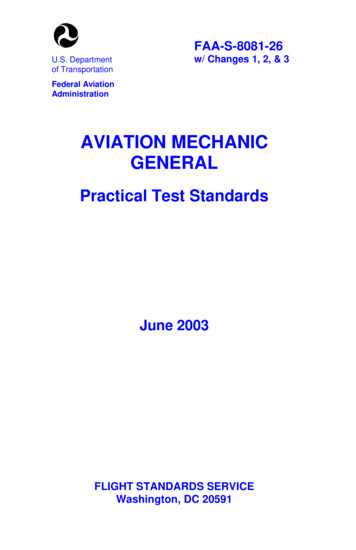
Transcription
FAA-S-8081-26U.S. Departmentof Transportationw/ Changes 1, 2, & 3Federal AviationAdministrationAVIATION MECHANICGENERALPractical Test StandardsJune 2003FLIGHT STANDARDS SERVICEWashington, DC 20591
AVIATION MECHANICGENERALPRACTICAL TESTSTANDARDS2003FLIGHT STANDARDS SERVICEWashington, D.C. 20591
NOTEFAA-S-8081-26, Aviation Mechanic General Practical TestStandards (PTS) is to replace the oral and practical test guidescurrently used. Both testing procedures will be in effect until allexaminers have been trained to administer the test inaccordance with the PTS, or 2 years after the effective date ofOrder 8610.4J, Aviation Mechanic Examiner Handbook. Afterwhich time, all tests must be administered under the PTSguidelines. New examiners must use the PTS upon completionof initial training. Previously appointed examiners must transitionto the PTS within 60 days after completion of recurrent training.
Record of ChangesChange 1: 8/8/2003IntroductionPerformance LevelsLEVEL 1—Z3b. Nondestructive changed to specified.LEVEL 1—PERFORMANCE STANDARD deleted.LEVEL 2—bullet 2: added additional text.LEVEL 2—PERFORMANCE STANDARD deleted.LEVEL 3—bullet 4: added additional text.LEVEL 3—Z3e. Verify changed to check.LEVEL 3—PERFORMANCE STANDARD deleted.Change 2: 9/24/2003IntroductionPerformance LevelsLEVEL 1—PERFORMANCE STANDARD added.LEVEL 2—PERFORMANCE STANDARD added.LEVEL 3—PERFORMANCE STANDARD added.Section 1—Aviation Mechanic GeneralA. Basic Electricity, Objective 1. Change “at least four” to “atleast two.”B. Aircraft Drawings, Objective 1. Change “at least four” to “atleast two.”C. Weight and Balance, Objective 1. Change “at least four”to “at least two.”D. Fluid Lines and Fittings, Objective 1. Change “at leastfour” to “at least two.”D. Fluid Lines and Fittings, Objective 2 a. Added the words“fabrication and tubefittings.E. Materials and Processes, Objective 1. Change “at leastfour” to “at least two.”F. Ground Operation and Servicing, Objective 1. Change “atleast four” to “at least two.”G. Cleaning and Corrosion Control, Objective 1. Change“at least four” to “at least two.”H. Mathematics, Objective 1. Change “at least four” to “atleast two.”I. Maintenance Forms and Records, Objective 1. Change“at least four” to “at least two.”J. Basic Physics, Objective 1. Change “at least four” to “atleast two.”K. Maintenance Publications, Objective 1. Change “at leastfour” to “at least two.”L. Aviation Mechanic Privileges and Limitations, Objective 1.Change “at least four” to “at least two.”
Change 3: 6/21/2004IntroductionUnsatisfactory Performance (Page 6)Section 1—Aviation Mechanic GeneralA.B.C.E.F.G.K.Basic ElectricityAircraft DrawingsWeight and BalanceMaterials and ProcessesGround Operation and ServicingCleaning and Corrosion ControlMaintenance Publications
FOREWORDThis Aviation Mechanic General Practical Test Standards bookhas been published by the Federal Aviation Administration(FAA) to establish the standards for the Aviation MechanicGeneral Practical Test. The passing of this practical test is arequired step toward obtaining the Aviation Mechanic certificatewith Airframe and/or Powerplant ratings. FAA inspectors andDesignated Mechanic Examiners (DMEs) shall conductpractical tests in compliance with these standards.Applicants should find these standards helpful in practical testpreparation./s/ 2-13-2003Joseph K. Tintera, ManagerRegulatory Support DivisionFlight Standards Service
CONTENTSIntroduction. 1Practical Test Standard Concept . 2Practical Test Book Description . 2Practical Test Standard Description. 2Use of the Practical Test Standards. 3Aviation Mechanic Practical Test Prerequisites . 4Examiner Responsibility . 4Performance Levels . 4Satisfactory Performance. 6Unsatisfactory Performance. 6SUBJECT AREASSECTION I—AVIATION MECHANIC GENERALA.B.C.D.E.F.G.H.I.J.K.L.BASIC ELECTRICITY. 1-1AIRCRAFT DRAWINGS . 1-2WEIGHT AND BALANCE . 1-3FLUID LINES AND FITTINGS . 1-4MATERIALS AND PROCESSES. 1-5GROUND OPERATION AND SERVICING . 1-6CLEANING AND CORROSION CONTROL . 1-7MATHEMATICS . 1-8MAINTENANCE FORMS AND RECORDS . 1-9BASIC PHYSICS . 1-10MAINTENANCE PUBLICATIONS . 1-11AVIATION MECHANIC PRIVILEGES ANDLIMITATIONS . 1-12iFAA-S-8081-26
INTRODUCTIONThe Flight Standards Service of the Federal Aviation Administration (FAA)has developed this practical test book as a standard to be used by FAAinspectors and Designated Mechanic Examiners (DMEs) when conductingaviation mechanic practical tests. Applicants are expected to use this bookwhen preparing for practical testing.Information considered directive in nature is described in this practical testdocument in terms, such as “shall” and “must” indicating the actions aremandatory. Guidance information is described in terms, such as “should”and “may” indicating the actions are desirable or permissive but notmandatory.The FAA gratefully acknowledges the valuable assistance provided by themany individuals and organizations that contributed their time and talent inassisting with the development of these practical test standards.This practical test standard may be downloaded from the RegulatorySupport Division’s, AFS-600, web site at http://afs600.faa.gov.Subsequent changes to this standard, in accordance with AC 60-27,Announcement of Availability: Changes to Practical Test Standards, willalso be available on AFS-600’s web site and then later incorporated into aprinted revision.This publication can be purchased from the Superintendent of Documents,U.S. Government Printing Office, Washington, DC 20402. The officialonline bookstore web site for the U.S. Government Printing Office iswww.access.gpo.gov.Comments regarding this document should be sent to:U.S. Department of TransportationFederal Aviation AdministrationRegulatory Support DivisionAirman Testing Standards Branch, AFS-630P.O. Box 25082Oklahoma City, OK 731251FAA-S-8081-26
Practical Test Standard ConceptTitle 14 of the Code of Federal Regulations (14 CFR) specifies the subjectareas in which knowledge and skill must be demonstrated by the applicantbefore the issuance of an Aviation Mechanic Certificate with an airframeand/or powerplant rating. The CFRs provide the flexibility that permits theFAA to publish practical test standards containing knowledge and skillspecifics in which competency must be demonstrated."Knowledge" (oral) elements are indicated by use of the words"Exhibits knowledge of.""Skill" (practical) elements are indicated by the use of the words"Demonstrates the ability to."The FAA will revise this book whenever it is determined that changes areneeded. Adherence to the applicable regulations, the policies set forthin the current revision of FAA Order 8610.4, Aviation MechanicExaminer Handbook, and the practical test standards is mandatoryfor the evaluation of aviation mechanic applicants.Practical Test Book DescriptionThis test book contains the following Aviation Mechanic Practical TestStandards.Section I—Aviation Mechanic GeneralPractical Test Standard DescriptionThe Aviation Mechanic Practical Test Standards include the subject areasof knowledge and skill for the issuance of an aviation mechanic certificateand/or the addition of a rating. The subject areas are the topics in whichaviation mechanic applicants must have knowledge and/or demonstrateskill.The REFERENCE identifies the publication(s) that describe(s) the subjectarea. Descriptions of the subject area are not included in the practical teststandards, because this information can be found in references listedand/or in manufacturer or FAA-approved or acceptable data related toeach subject area. Publications other than those listed may be used asreferences if their content conveys substantially the same information asthe referenced publications. Except where appropriate, (e.g., pertinentCFRs) references listed in this document are NOT meant to supersede orotherwise replace manufacturer or other FAA-approved or acceptable data,but to serve as general information and study material Aapproved/acceptable data always takes precedence over advisory ortextbook referenced data. Written instructions given to applicants for theFAA-S-8081-262
completion of assigned skill portions of the practical test standard mayinclude service bulletins; airworthiness directives or other CFRs; typecertificate data sheets or specifications; manufacturer maintenancemanuals or other similar approved/acceptable data necessary foraccomplishment of objective testing.Reference List:14 CFR part 114 CFR part 2114 CFR part 4314 CFR part 6514 CFR part 91ABSAC 65-9AC 65-15AEEAMRAMT-GFAA-H-8083-1JSATJSGTDefinitions and AbbreviationsCertification Procedures for Products and PartsMaintenance, Preventive MaintenanceRebuilding, and AlterationCertification: Airmen Other Than FlightCrewmembersAir Traffic and General Operating RulesAircraft Basic Science, Glencoe—Macmillan/McGraw-Hill Publishing Co.Airframe and Powerplant Mechanics GeneralHandbookAirframe and Powerplant Mechanics AirframeHandbookAircraft Electricity and Electronics, Glencoe—Macmillan/MacGraw-Hill Publishing Co.Aircraft Maintenance and Repair, Glencoe—Macmillan/MacGraw-Hill Publishing Co.Aviation Maintenance Technician Series—General, Aviation Supplies and Academics(ASA), Inc.Aircraft Weight and Balance HandbookA & P Technician Airframe Textbook—JeppesenSandersen, Inc.A & P Technician General Textbook—JeppesenSandersen, Inc.Each subject area has an objective. The objective lists the importantknowledge and skill elements that must be utilized by the examiner inplanning and administering aviation mechanic tests, and that applicantsmust be prepared to satisfactorily perform.EXAMINER is used in this standard to denote either the FAA Inspector orFAA Designated Mechanic Examiner (DME) who conducts the practicaltest.Use of the Practical Test StandardsThe FAA requires that all practical tests be conducted in accordance withthe appropriate Aviation Mechanic Practical Test Standards and thepolicies and procedures set forth in the current revision of FAA Order8610.4. When using the practical test book, the examiner must evaluatethe applicant’s knowledge and skill in sufficient depth to determine that theobjective for each subject area element selected is met.3FAA-S-8081-26
An applicant is not permitted to know before testing begins whichselections in each subject area are to be included in his/her test (exceptthe core competency elements, which all applicants are required toperform). Therefore, an applicant should be well prepared in all oral andskill areas included in the practical test standard.Further information about the requirements for conducting/taking thepractical test is contained in FAA Order 8610.4Aviation Mechanic Practical Test PrerequisitesAll applicants must have met the prescribed experience requirements asstated in 14 CFR part 65, section 65.77. (See FAA Order 8610.4 forinformation about testing under the provisions of 14 CFR part 65, section65.80.)Examiner ResponsibilityThe examiner who conducts the practical test is responsible fordetermining that the applicant meets acceptable standards of knowledgeand skill in the assigned subject areas within the appropriate practical teststandard. Since there is no formal division between the knowledge and skillportions of the practical test, this becomes an ongoing process throughoutthe test.The following terms may be reviewed with the applicant prior to, or during,element assignment.1.2.3.4.5."Inspect" means to examine by sight and/or touch (with orwithout inspection enhancing tools/equipment)."Check" means to verify proper operation."Troubleshoot" means to analyze and identify malfunctions."Service" means to perform functions that assure continuedoperation."Repair" means to correct a defective condition.Performance LevelsThe following is a detailed description of the meaning of each level.Level 1 Know basic facts and principles.Be able to find information and follow directions and writteninstructions.Locate methods, procedures, instructions, and reference material.Interpretation of information not required.No skill demonstration is required.FAA-S-8081-264
Example:Z3b.Change 1 (8/8/2003) & 2 (9/24/03)Locate specified nondestructive testing methods. (Level 1)Performance Standard: The applicant will locate information fornondestructive testing.Level 2 Know and understand principles, theories, and concepts.Be able to find and interpret maintenance data and information,and perform basic operations using the appropriate data, tools,and equipment.A high level of skill is not required.Example:Z3c.Detect electrical leakage in electrical connections, terminal strips,and cable harness (at least ten will have leakage faults). (Level 2)Performance Standard: Using appropriate maintenance data and amultimeter, the applicant will identify items with leakage faults.Le
Order 8610.4J, Aviation Mechanic Examiner Handbook. After which time, all tests must be administered under the PTS guidelines. New examiners must use the PTS upon completion of initial training. Previously appointed examiners must transition to the PTS within 60 days after completion of recurrent training. Record of Changes Change 1: 8/8/2003 Introduction Performance Levels LEVEL 1—Z3b .
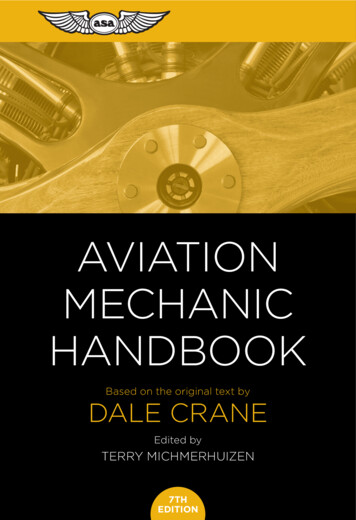

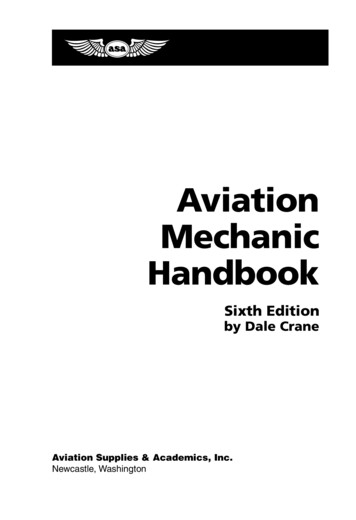
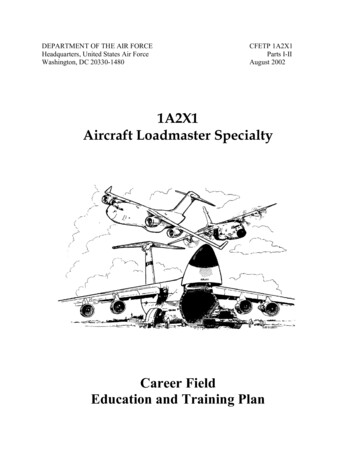
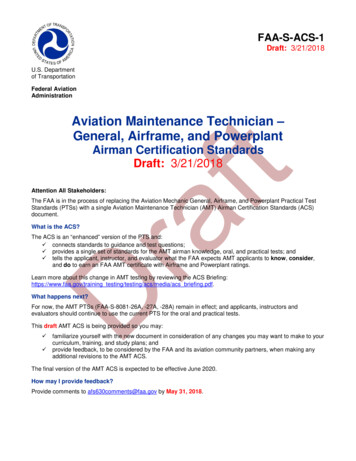
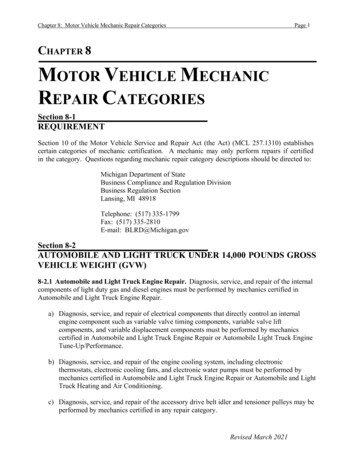
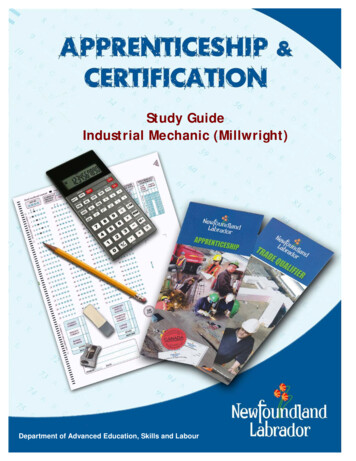
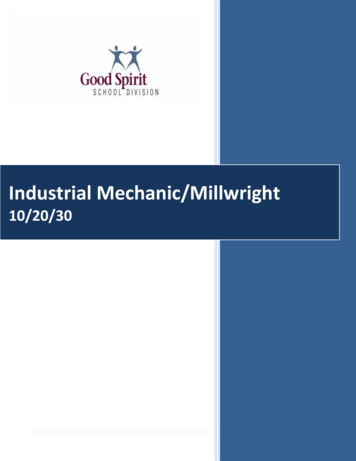
![Motorcycle Mechanic [MM] - CTEVT](/img/5/motorcycle-20-20mechanic-2010.jpg)
